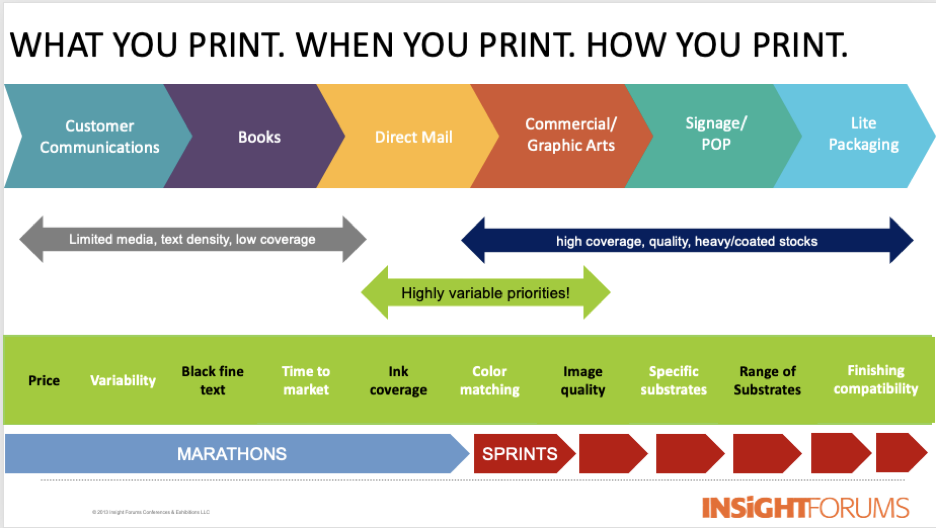Back in 2013, I participated in a panel presentation on digital and offset economic crossover points with several industry luminaries with whom I immediately, yet politely, began to argue. Actually, Marco Boer and I were both arguing on what we felt was the side of the angels against a number of traditional “facts” about print economics. It was pretty common at that time to throw out a number, like 5,000 or 4,000, as the break-even number under which it did not make sense to run a job on offset, or conversely above which it did not make sense to run on inkjet (or any digital press.) Sometimes the number was defined in terms of US letter or A4 images and sometimes it was not defined at all. The lack of definition extended to the type of inkjet and offset being compared. These discussions, and oft cited charts, made no reference to characteristics like web, sheet, type of ink, coverage, target media, or number of colors that can influence breakeven calculations.
In contrast, it was very refreshing to be invited by Kodak to lead a panel of experts discussing how the “sweet spot” for particular print processes must consider a range of print-operation specific variables. In the ten years since the first panel, this discussion has only become more complex. The top speed for inkjet presses has risen along with color and other measures for top quality. At the same time, offset make-ready times have shrunk and great strides have been made in trimming waste from the process. Neither technology is standing still.
My co-presenters for the session “Find your sweet spot: the crossover from offset to inkjet” deal with these variables every day.
- Patrick Murray, President of Japs Olson has an enviable range of equipment, including both web and sheetfed offset and digital presses, to drive what he calls a “total package direct mail producer mailing well over 1 billion pieces per year.” I learned in a previous interview with Pat that, before they acquired their first inkjet press in 2014, Japs Olson had over 100 inkjet printheads deployed on hybridized offset equipment.
- Jennifer Wren is a Color Commercialization Engineer with Kodak, where she balances her time between product development initiatives and being out in the field talking to customers about real-world printing challenges. It’s important to note that Kodak derives roughly one third of the revenue from its digital printing segment that it does from its traditional printing, so they have a foot firmly in each camp.
One thing that we all agreed on is that what you are running, and how you are running it, have a huge impact on the economic crossover point for justifying the type of press to invest in as well the day to day running of equipment. In terms of what you run, the type and variety of applications that a press needs to handle has a big impact of the capabilities that will be a priority (see chart below). For companies working in customer communications and monochrome books, fine text legibility and price will be more important than breadth of media, coverage or color quality. At the other end of the spectrum, if you are bridging graphic arts up to light packaging, media range, coverage and image quality become paramount.

Pat said that this chart really captured Japs Olson’s considerations, “We are right in the middle. In the direct mail space there is a lot of personalization and a lot of demand on color and quality, and speed to market is so important. The other piece that is important is finishing capabilities.” He noted that it was important for Japs Olson to be able to use the same finishing equipment with their inkjet equipment that they do with offset to enable flexibility when deciding how to run a job. Pat noted, “When we first purchased our Prosper 6000, it was intended for 4 color variable work only. We wanted to get into that world. We’re finding out that this equipment is really versatile. It’s not for everything but we’ve found a lot more we can run. A lot of static work runs really well on this equipment.”
It’s often the case that when making the business case to purchase a press, there is a specific business case in mind. These days more companies are trying to get into new areas of work, and, in that case, it’s important to look at whether new equipment will be flexible enough to support different requirements. Even if you already know that you want to buy a continuous inkjet press, for instance, your business case needs to consider the specific configuration to support all of the work you want to produce. There might be different drying options or automatic winding or priming or even ink options.
Once you have a press in-house and are trying to optimize volumes across the available equipment, the job characteristics and specific customer priorities can be as important as the volume itself. Jen advised “ There is not a given path that a job has to take to a certain press. It can go in a lot of directions – it could go to offset or to inkjet and there are a lot of different factors to analyze.” If you want to see the details of examples that Jen showed for how the economics change based on number of signatures in a job and other considerations, tune into the webinar replay here.
Of course job volume is an important factor. For our conversation, we talked about volume in terms of marathons and sprints rather than specific run lengths because overall productivity is generally the goal. The same number of jobs and volume running on several different types of media instead of a single media has a significant impact on the efficiency of a continuous inkjet device. It may have no impact on a sheetfed inkjet press with more than one paper feed. Conversely, plate changes are needed every time there is a change to an offset job, so the time for media changes is already “baked in” to the default make-ready penalty on offset jobs. However, that make-ready penalty will be drastically lower for a highly efficient late-model offset press with the latest workflow software than with a 20 year old offset press lacking in automation. It’s important to talk about specific equipment, not just general categories
For many years Japs Olson bought into the generalization that you couldn’t move sheet fed offset volumes to inkjet because the quality would never be acceptable and that roll-fed offset was so fast that inkjet would never be efficient enough. Now they keep an open mind. Pat noted that ink coverage is a big factor in the decision process of where to run a job. “We can run the Prosper 6000 up to 1,000 feet per minute on uncoated stock. And when you look at quality, the thing that keeps blowing our minds is that the lines on quality are getting blurred. Litho is still better, but it’s getting really close.”
Pat said that with the wide variety of digital, offset and hybrid equipment they have running, they are constantly evaluating the sweet spot for their jobs and specific customer priorities, “What everyone who goes through this journey has to do is determine their own sweet spot. For Japs Olson, we produce hundreds of formats. The format and ink coverage and how it’s going to finish are all factors. Our estimating team has been tasked with doing the compare and we continue to find wins. We have moved a lot of static work off of our web offset and onto our Prosper press. The factors there were quantity, quality, ink coverage – all those factors we talked about today need to be taken into consideration. For us, there is a certain ink coverage that is our sweet spot and over that it usually makes more sense to go litho. “
Production cost is usually top of mind for most production operations, but with direct mail, time to market is a big factor that can enable premium pricing. One of the factors that drives down inkjet costs is lower labor cost, which is important in the current market. Pat says, with inkjet “You’re able to train people in half the time that you would on a large litho press. You can have someone productive in a couple of weeks and easily move people around.”
As you can see, there are a lot of factors that go into driving the business case for the type of press you invest in and even more for determining the best place to run an individual job. The “sweet spot” can shift by customer, peak times, or even as you add capacity and try to load balance across equipment. Technology and workflow improvements will continue to impact the cross over points and optimal run economics can also be affected by outside factors like supply chain or labor challenges. Pat summed it up pretty clearly as, “Print and technology is evolving and we have to evolve with it. “ Our industry’s tendency to oversimplify break-even considerations needs to evolve too.

